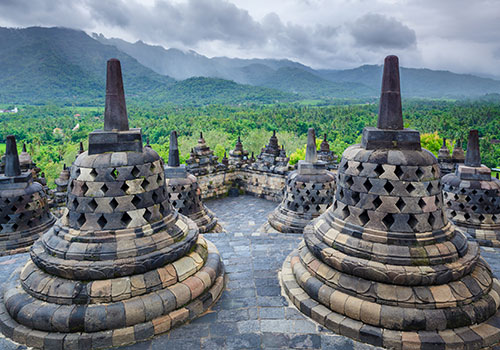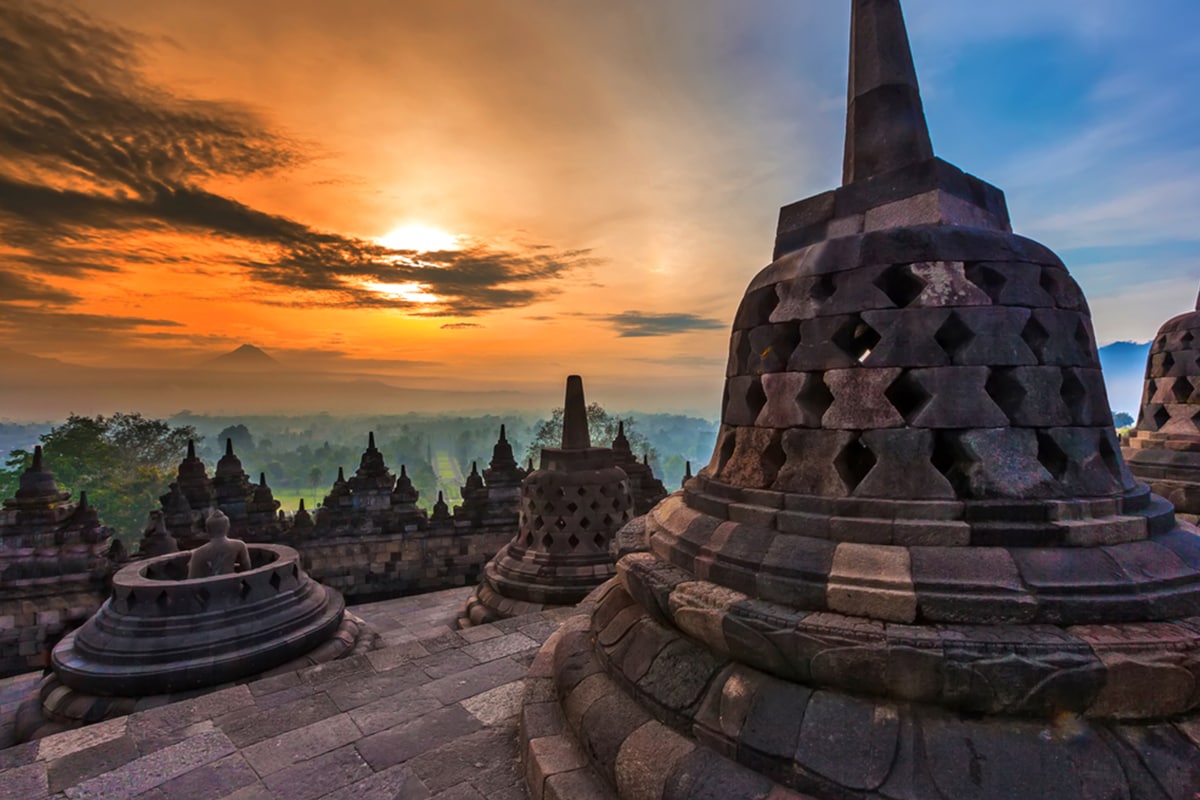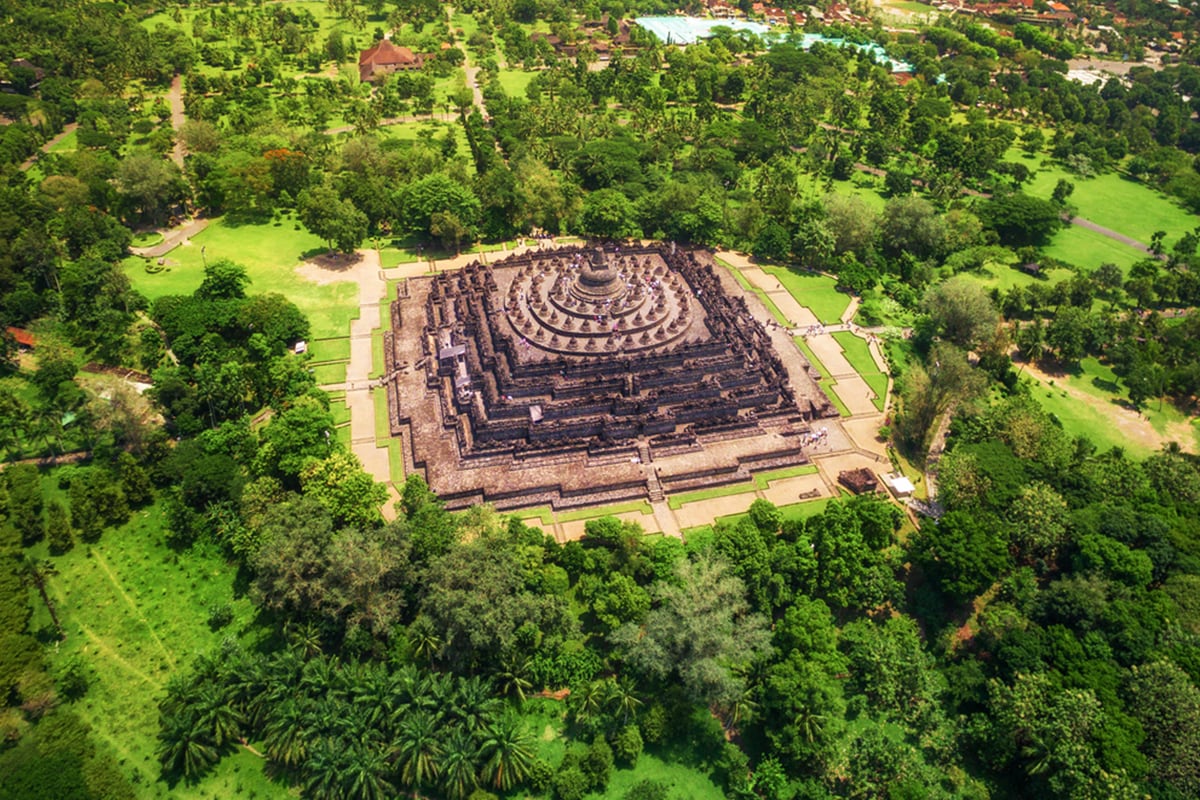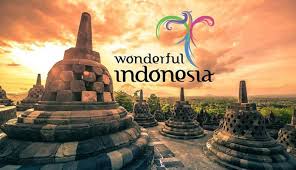Located on the island of Java, the magnificent Borobudur temple is the world’s biggest Buddhist monument, an ancient site widely considered to be one of the world’s seven wonders. The temple sits majestically on a hilltop overlooking lush green fields and distant hills. Built in the 9th century during the reign of the Syailendra dynasty, the temple’s design in Gupta architecture reflects India's influence on the region, yet there are enough indigenous scenes and elements incorporated to make Borobudur uniquely Indonesian.
Borobudur
is the biggest Buddhist temple in the ninth century measuring 123 x 123
meters. It is located at Magelang, 90-km southeast of Semarang, or
42-km northwest of Yogyakarta. Borobudur temple is the one of the
best-preserved ancient monument in Indonesia that are most frequently
visited by over a million domestic as well as foreign visitors. It also
had been acclaimed by the world as a cultural heritage main kind. The
architectural style has no equal through out the world. It was completed
centuries before Angkor Wat in Kamboja. Borobudur is one of the world's
most famous temples; it stands majestically on a hilltop overlooking
lush green fields and distant hills. Borobudur is built of gray andesite
stone. It rises to seven terraces, each smaller than the one below it.
The top is the Great Stupa, standing 40 meters above the ground. The
walls of the Borobudur are sculptured in bas-reliefs extending over a
total length of six kilometers. It has been hailed as the largest and
most complete ensemble of Buddhist relieves in the world, unsurpassed in
artistic merit and each scene an individual masterpiece.
Borobudur
temple built in the eighth century by the Cailendra dynasty, is
believed to have been derived from the Sanskrit words "Vihara Buddha
Uhr" the Buddhist Monastery on the hill. Borobudur is a terraced temple
surmounted by stupas, or stone towers; the terraces resemble Indonesian
burial foundations, indicating that Borobudur was regarded as the symbol
of the final resting place of its founder, a Syailendra, who was united
after his death with the Buddha. The Prambanan temple complex is also
associated with a dead king. The inscription of 856 mentions a royal
funeral ceremony and shows that the dead king had joined Shiva, just as
the founder of the Borobudur monument had joined the Buddha. Divine
attributes, however, had been ascribed to kings during their lifetimes. A
Mahayana inscription of this period shows that a ruler was said to have
the purifying powers of a bodhisattva, the status assumed by the ruler
of Shrivijaya in the 7th century; a 9th-century Shaivite inscription
from the Kedu Plain describes a ruler as being "a portion of Shiva."
The
Borobudur was in danger of collapsing as its stone statues and stone
cancer, moss and lichen affected bas-reliefs. But, the monument has been
completely restored and was officially opened by the President on 23rd
February 1983. The restoration took eight years to complete, funded by
the Government of Indonesia with aid from the UNESCO and donations from
private citizens as well as from foreign governments.
The
visitors have the option of going by taxi or public bus to reach this
temple. Public transportation is available from the bus terminal. From
that point visitors can hire becaks or horse carts, or walk the rest of
the way to the monument. A large parking area is available not far from
the monument, so private cars and buses can park in this area.
It
covers an enormous area, measuring 123 x 123 meters. The monument is a
marvel of design, decorated with 2,672 relief panels and 504 Buddha
statues. The architecture and stonework of this temple has no equal. And
it was built without using any kind of cement or mortar! The structure
is like a set of massive interlocking Lego blocks held together without
any glue.
The temple has remained strong even through ten centuries
of neglect. It was rediscovered in 1815, buried under volcanic ash. In
the 1970’s the Indonesian Government and UNESCO worked together to
restore Borobudur to its former majesty The restoration took eight years
to complete and today Borobudur is one of Indonesia and the world’s
most valuable treasures.
The temple has remained strong even through
ten centuries of neglect. It was rediscovered in 1815, buried under
volcanic ash. In the 1970’s the Indonesian Government and UNESCO worked
together to restore Borobudur to its former majesty The restoration took
eight years to complete and today Borobudur is one of Indonesia and the
world’s most valuable treasures.
The temple is decorated with stone
carvings in bas-relief representing images from the life of Buddha.
Commentators claim that this is the largest and most complete ensemble
of Buddhist reliefs in the world, unsurpassed in artistic merit.
Get Around
The
best way to explore this site is on foot. As you climb to the top of
this magnificent temple you will marvel at the intricate detailed stone
carvings displayed on the temples walls. You will certainly miss a great
experience if you visit this enormous temple without learning about its
history and importance which are captured on its many reliefs.



